
king size bed frame plans pdf
Welcome to our comprehensive guide on king size bed frame plans! Discover how to create a stunning and durable bed frame using free PDF guides and step-by-step tutorials. Perfect for DIY enthusiasts, these plans offer customizable designs, cost-effective solutions, and easy-to-follow instructions to enhance your bedroom.
Overview of King Size Bed Dimensions
A standard king size bed measures 76 inches in width and 80 inches in length, making it ideal for spacious bedrooms. These dimensions ensure ample sleeping area for two people. The height typically ranges between 36 to 38 inches, depending on the frame design. When planning your DIY project, ensure your king size bed frame plans account for these measurements to fit your mattress perfectly. Always double-check your mattress dimensions, as variations like California King (72″ x 84″) may differ slightly. Proper sizing ensures a comfortable and functional bed frame.
Why Choose DIY King Size Bed Frame Plans?
Building a king size bed frame yourself offers significant advantages. DIY projects save money, often costing a fraction of store-bought frames. They also allow for customization, letting you tailor the design, material, and style to fit your bedroom decor. With PDF plans, you get clear instructions, shopping lists, and diagrams, making the process manageable even for beginners. Additionally, DIY projects enable the use of reclaimed or sustainable wood, promoting eco-friendliness. This approach ensures a sturdy, personalized bed frame that enhances your space while reflecting your creativity and skill.
Popular Styles of King Size Bed Frames
When exploring king size bed frame plans, popular styles include farmhouse, modern, rustic, and platform designs. Farmhouse plans often feature sturdy wood and classic aesthetics, while modern styles emphasize sleek lines and minimalism. Rustic designs incorporate natural textures and reclaimed wood for a cozy feel. Platform beds are low-profile and versatile, often with storage options. These styles cater to various decor preferences, allowing you to choose a design that complements your bedroom. DIY plans also enable customization, such as adding storage drawers or upholstered headboards, ensuring a perfect fit for your space and needs.

Benefits of Building a King Size Bed Frame
Building a king size bed frame offers durability, personal satisfaction, and the ability to tailor the design to your bedroom’s unique style and space requirements.
Cost Savings Compared to Store-Bought Frames
Building a king size bed frame using DIY plans saves money by avoiding retail markups. Materials and tools are affordable and widely available at hardware stores. By cutting out the middleman, you can reduce costs significantly—often by 70% or more. Additionally, DIY projects allow you to customize without extra fees, ensuring you only pay for what you need. This approach not only saves money but also lets you achieve a high-quality, durable bed frame without compromising on style or functionality.
Customization Options for Your Bedroom
DIY king size bed frame plans offer unparalleled customization to match your bedroom decor. Choose from various styles, such as modern, rustic, or farmhouse designs. You can select materials like reclaimed wood, metal, or upholstery to suit your preferences. Additionally, you can add features like storage drawers, shelves, or carved details. This flexibility allows you to create a bed frame that perfectly aligns with your room’s aesthetic and functional needs, ensuring a personalized and unique piece of furniture that enhances your bedroom’s overall appearance and functionality.
Environmental Benefits of Using Reclaimed Wood
Using reclaimed wood for your king size bed frame offers significant environmental benefits. It reduces the demand for new lumber, preserving trees and forests. Reclaimed wood also decreases landfill waste by repurposing materials that would otherwise be discarded. This sustainable approach lowers the carbon footprint associated with manufacturing and transporting new wood products. Additionally, it helps conserve natural resources and supports eco-friendly practices. By choosing reclaimed wood, you create a durable and unique bed frame while contributing to a greener planet and promoting responsible woodworking practices.
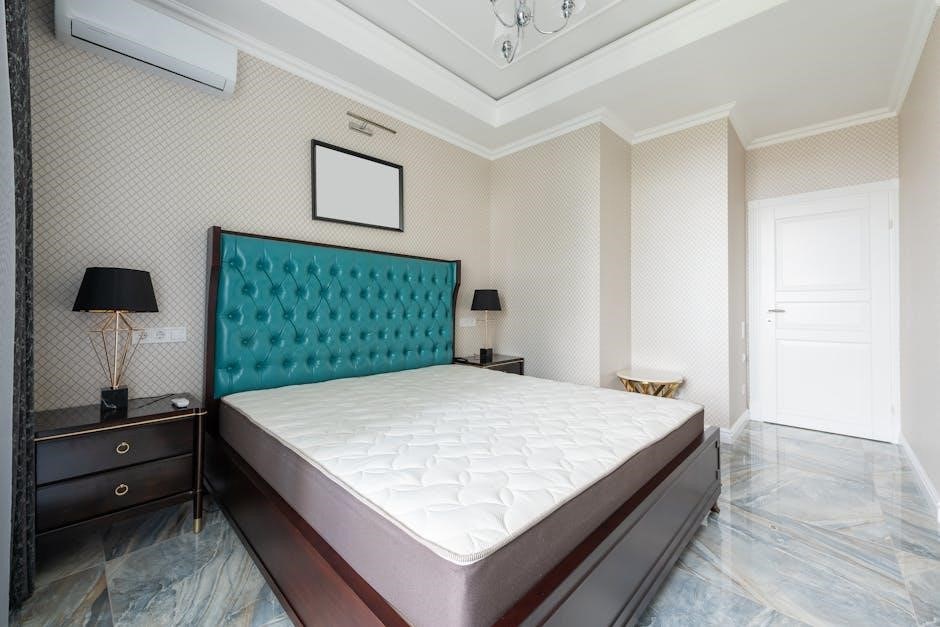
Materials and Tools Needed
The essential materials include sturdy lumber, screws, wood glue, and sandpaper. Tools required are a circular saw, drill, sander, tape measure, level, and clamps. Ensure all items are readily available before starting your project for smooth progress.
Essential Lumber and Hardware Requirements

For a sturdy king size bed frame, use high-quality lumber such as pine, cedar, or MDF. Typical requirements include 2x4s for the frame, 2x6s for support, and 3/4-inch plywood for the mattress base. Hardware essentials include wood screws, bolts, and brackets to ensure stability. Sandpaper and wood glue are also necessary for a smooth finish. Many PDF plans provide detailed cut lists and hardware specifications, ensuring you have everything needed before starting your project. Reclaimed wood can also be used for an eco-friendly option.
Power Tools and Hand Tools for the Project
To build a king size bed frame, essential power tools include a circular saw, drill, impact driver, and orbital sander. Hand tools like tape measures, clamps, and screwdrivers are also crucial. Many PDF plans list specific tools needed, ensuring you’re prepared. Having the right tools ensures a smooth and efficient assembly process, helping you achieve professional-quality results for your DIY bed frame project.
Finishing Materials for a Polished Look
To achieve a professional finish, consider using high-quality stains, paints, or polyurethane. These materials protect the wood and enhance its appearance. Sanding the frame before applying finishes ensures a smooth, even surface. Many PDF plans include recommendations for specific finishes to match your desired aesthetic, whether modern or rustic.
Additional touches like decorative hardware or upholstery can elevate the design. Proper finishing not only enhances durability but also adds a polished look to your custom king size bed frame, making it a centerpiece of your bedroom.
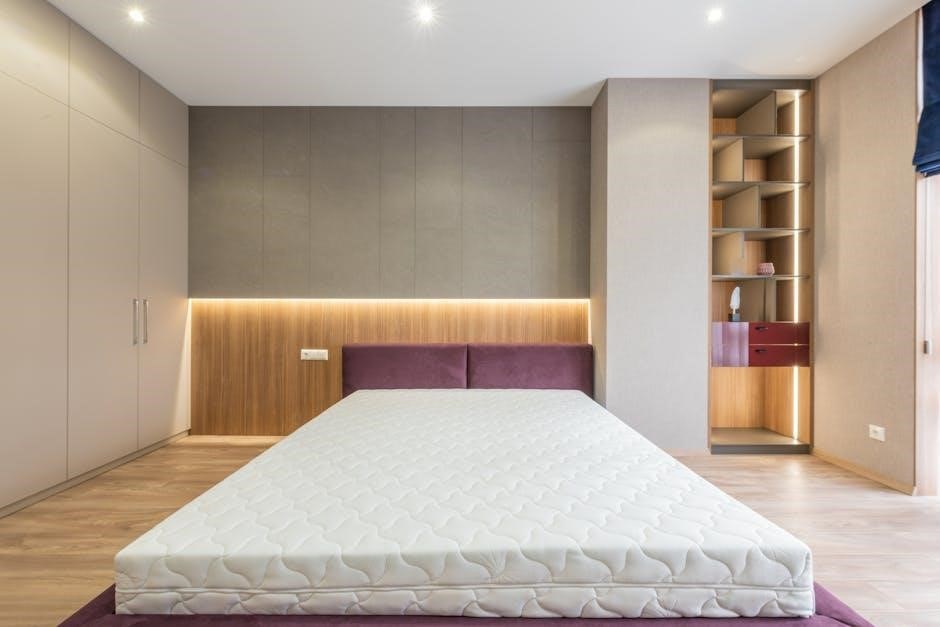
Step-by-Step King Size Bed Frame Plans
Follow detailed guides with diagrams and tutorials for building a king size bed frame. These PDF plans include cut lists and step-by-step instructions for a perfect build.
Preparation and Cutting of Lumber
Begin by gathering all materials and tools, ensuring lumber matches your king size bed frame plans. Measure and mark wood accurately, following the cut list in your PDF guide. Use a circular saw or miter saw for precise cuts, and sand edges for smoothness. Organize cut pieces by label or diagram to avoid confusion. Double-check measurements before cutting to prevent waste. Safety is key—wear protective gear and work in a well-ventilated area. Proper preparation ensures a seamless assembly process for your bed frame.
Assembly of the Bed Frame Components
Start by assembling the bed frame components according to your PDF plans. Attach side rails to the headboard and footboard using screws or bolts. Ensure all joints are secure and aligned properly. Use clamps to hold pieces in place while drilling pilot holes to avoid splitting the wood. Follow the diagrams for accurate placement of slats or supports. Double-check the frame’s squareness before moving forward. Sand any rough edges and tighten all connections for stability. This step sets the foundation for a sturdy and professional-looking bed frame.
Attaching the Headboard and Footboard
Securely attach the headboard and footboard to the bed frame using screws or bolts. Ensure proper alignment by matching pre-drilled holes or marks from your PDF plan. Tighten connections firmly but avoid overtightening, which could strip the wood. If your design includes, use brackets or supports for added stability. Check the fit before fully tightening to make sure everything aligns perfectly. Use a level to ensure the headboard and footboard are straight. Sand any rough edges for a smooth finish. This step completes the structural assembly, readying the frame for support slats or a mattress base.
Installing Support Slats and Mattress Base
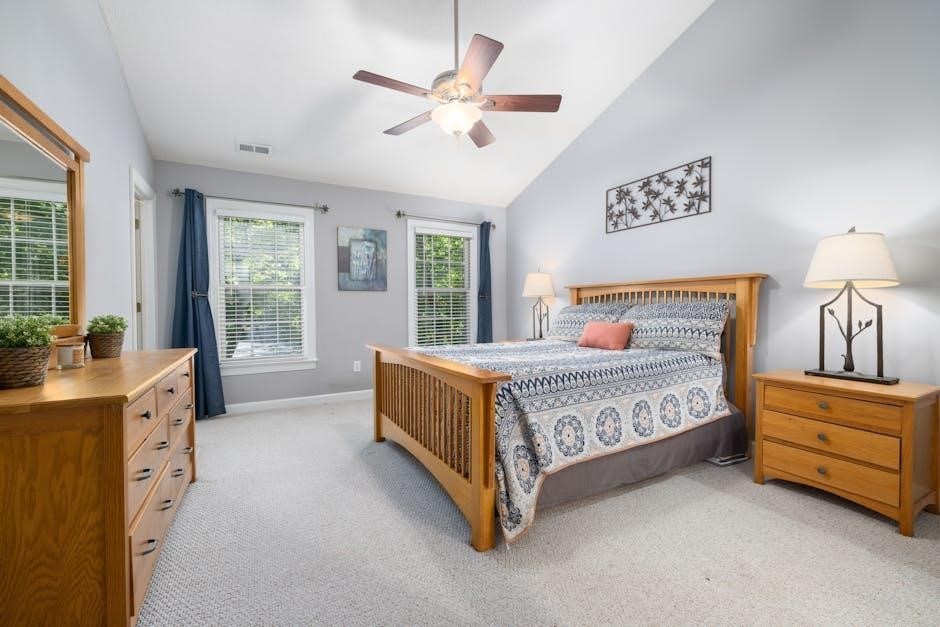
Design Considerations and Customization
Design your king-size bed frame to balance aesthetics and functionality. Choose between modern, rustic, or farmhouse styles. Customize with storage drawers, shelves, or upholstery for a personalized touch.
Modern vs. Rustic Design Approaches
Modern designs emphasize sleek lines, minimal ornamentation, and a clean aesthetic, often using materials like metal or engineered wood. Rustic designs, however, celebrate natural beauty, incorporating reclaimed wood and traditional craftsmanship. Both styles offer unique charm, allowing you to tailor your king-size bed frame to your personal taste. Modern frames suit contemporary spaces, while rustic frames evoke a cozy, timeless feel. Choose the approach that aligns with your bedroom decor for a cohesive and inviting atmosphere.
Adding Storage Drawers or Shelves
Incorporating storage drawers or shelves into your king-size bed frame is a practical way to maximize space while maintaining style. Many DIY plans include optional storage compartments, such as drawers underneath the bed or shelves on the headboard. These features are ideal for storing linens, clothes, or personal items. Modern designs often use sleek, hidden drawers, while rustic plans may include open shelving or decorative cabinets. Ensure measurements align with your mattress and bedroom layout for a seamless, functional design that enhances convenience without compromising aesthetics.
Incorporating Upholstery or Metal Accents
Add a touch of sophistication by integrating upholstery or metal accents into your king-size bed frame. Upholstered headboards, featuring tufted fabric or leather, create a luxurious, modern look. Metal accents, such as wrought-iron details or brass hardware, can add an industrial or glamorous vibe. These elements not only enhance aesthetics but also allow for customization to match your bedroom decor. Ensure the materials complement the bed’s structure and balance seamlessly with the overall design for a polished, cohesive appearance that elevates your bedroom’s style and comfort.

Safety Tips and Troubleshooting
Ensure your king-size bed frame is stable and secure to prevent accidents. Check for evenness and tighten all connections. Address warped wood promptly to maintain structural integrity.
Ensuring Stability and Structural Integrity
To ensure your king-size bed frame is stable and structurally sound, always use proper assembly techniques. Tighten all bolts and screws firmly, and verify the frame is even on the floor. Use clamps during assembly to hold pieces in place, and double-check all measurements before final tightening. Ensure the bed slats are evenly spaced and securely attached to prevent sagging. If using reclaimed wood, inspect for cracks or weaknesses. Adding metal brackets or reinforced joints can enhance durability. Always test the frame’s stability before placing the mattress to guarantee safety and longevity.
Common Mistakes to Avoid During Assembly
When assembling a king-size bed frame, avoid common mistakes like not pre-drilling holes, which can cause wood splits. Ensure all components are aligned correctly before tightening bolts, as misalignment can lead to a wobbly frame. Double-check the orientation of headboards and footboards to match the design. Avoid overtightening screws, as this may damage the wood or strip screws. Use clamps to hold pieces steady during assembly to prevent shifting. Always follow the plans step-by-step and measure twice before cutting or drilling to minimize errors.
Troubleshooting Warped or Uneven Frames
If your king-size bed frame becomes warped or uneven, check for loose joints and tighten bolts or screws. Use shims to level the frame on uneven floors. Ensure all slats are evenly spaced and securely attached to prevent sagging. If wood warping occurs, apply wood glue and clamps to realign the pieces, letting them dry completely. Avoid using damp wood, as it may warp over time. Regularly inspect the frame for structural integrity and address issues promptly to maintain stability and prevent further damage.

Budgeting and Time Management
Estimate costs for materials and tools, allocate time for each project stage, and use tips to stay within budget while building your king-size bed frame.
Estimating Costs for Materials and Tools
Estimating costs for materials and tools is crucial for budgeting. King-size bed frames typically cost between $150 to $300, depending on the design and materials. Farmhouse and modern plans may vary due to lumber and hardware requirements. Reclaimed wood can reduce expenses, while metal accents or upholstery may increase costs. Compare plans to find the best fit for your budget and ensure all materials are accounted for in your shopping list. Proper estimation helps avoid overspending and ensures project completion within financial limits.
Time Allocation for Each Stage of the Project
Allocate time wisely for each stage of your king-size bed frame project. Cutting and preparing lumber typically takes 2-3 hours, while assembling the frame and components may require 4-6 hours. Attaching the headboard and footboard can take an additional 2-4 hours, depending on design complexity. Finally, installing support slats and the mattress base usually needs 1-2 hours. Plan for breaks and potential adjustments, ensuring a total of 10-15 hours for the entire project. Proper time management ensures a smooth and efficient building process, resulting in a professional-quality bed frame.
Tips for Staying Within Budget
To stay within budget, start by using reclaimed or standard lumber, which is cost-effective. Plan your purchases carefully and shop during sales or discounts. Avoid intricate designs that require expensive materials. Opt for free or low-cost plans to minimize initial costs. Measure accurately to avoid wasting materials and consider repurposing old furniture parts. Finally, DIY as much as possible to save on labor costs. These tips will help you build a king-size bed frame without overspending, ensuring a stylish and functional result within your budget.
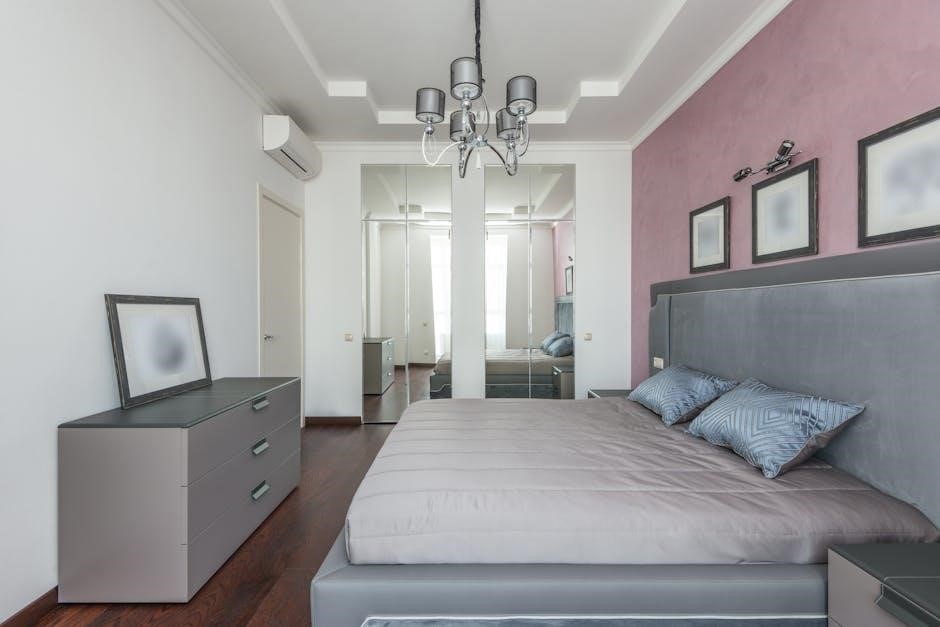
Comparing Homemade vs. Store-Bought Frames
Homemade frames offer customization and cost savings, while store-bought options provide convenience and immediate availability. Choose based on your budget, skills, and desired design flexibility.
Quality and Durability Differences
Homemade frames often surpass store-bought options in quality and durability due to the use of premium materials like reclaimed wood. Customization allows for precise craftsmanship, ensuring longevity. Store-bought frames may compromise on material quality to reduce costs, potentially affecting durability. Homemade frames can be tailored to exact needs, offering superior stability and a perfect fit. However, store-bought options are factory-tested for consistency. Ultimately, homemade frames provide a personal touch and long-term savings, while store-bought frames offer convenience and immediate availability.
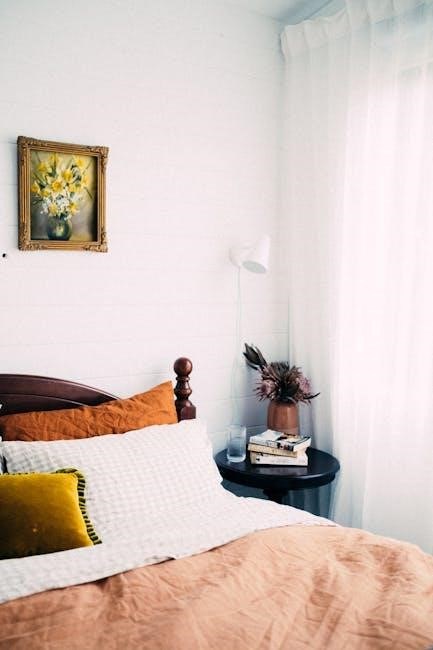
Aesthetic and Functional Advantages
DIY king size bed frames offer unmatched aesthetic customization, allowing you to match your bedroom decor perfectly. Choose from modern, rustic, or farmhouse designs. Functionally, homemade frames can include storage drawers, shelves, or headboard compartments, maximizing space. PDF plans often provide versatile designs adaptable to various styles. Homemade frames also avoid bulky designs found in some store-bought options, creating a sleek look. Additionally, custom upholstery or metal accents can enhance both beauty and functionality, making your bed the centerpiece of your room while serving practical needs.
Long-Term Cost Efficiency
Building a king size bed frame using PDF plans offers significant long-term savings. DIY projects often cost 1/10th of store-bought frames, as you avoid retail markups. Materials like reclaimed wood can further reduce expenses while adding eco-friendly benefits.
A well-built frame lasts years, eliminating the need for frequent replacements. Custom designs also ensure durability, as they’re tailored to your needs. Over time, the investment in materials and effort pays off, providing a stylish and functional bed frame that remains cost-efficient for years to come.
With these king size bed frame plans PDF, you can create a beautiful, functional bed while saving money. Remember to measure carefully, use quality materials, and enjoy the pride of your DIY creation!
Final Inspection and Touch-ups
After assembling your king size bed frame, conduct a thorough inspection to ensure all parts are secure and properly aligned. Check for any gaps, dents, or rough edges that may need sanding. Apply a final coat of paint, stain, or sealant to protect the wood and enhance the appearance. Install any hardware, such as drawer handles or metal accents, according to your design. Double-check the stability of the frame to ensure it can support the mattress and weight safely. Finally, add any decorative touches, like upholstery or trim, to complete your DIY project.
Maintenance and Care for Your New Bed Frame
To keep your king size bed frame looking its best, regular maintenance is essential. Dust the frame weekly with a soft cloth and clean any stains or spills immediately using a damp cloth. Avoid harsh chemicals or abrasive cleaners, as they may damage the finish. For wooden frames, apply a wood conditioner periodically to maintain the finish and prevent drying. Check and tighten screws or bolts every few months to ensure stability. If your frame has upholstered parts, vacuum fabric regularly and spot-clean stains. Protect the frame from direct sunlight to prevent fading or warping.
Encouragement to Share Your DIY Success
Sharing your DIY king size bed frame project is a great way to inspire others and showcase your creativity. Post photos of your finished bed on social media or DIY forums to connect with fellow woodworking enthusiasts. Many platforms allow you to share your project details, including materials used and challenges overcome. Your success story can motivate others to take on similar projects. Plus, it’s a wonderful way to celebrate your hard work and skill. Consider writing a blog or creating a video tutorial to help others replicate your achievement. Your DIY journey could spark creativity in someone else’s home!